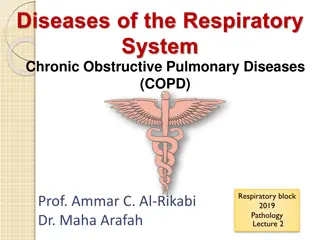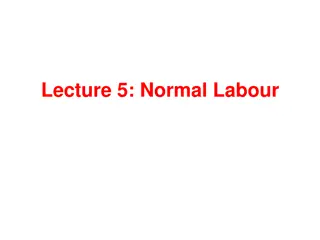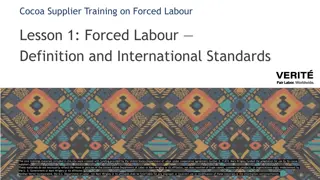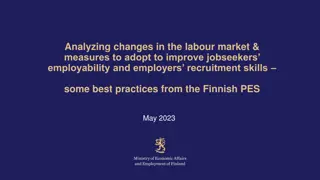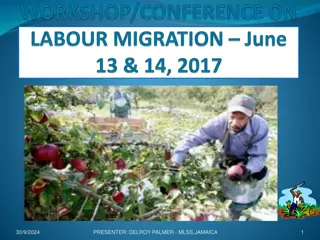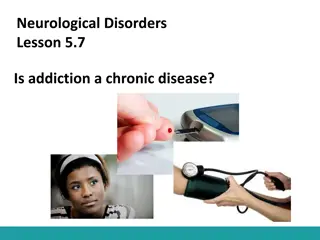Enhancing Labour Market Integration of Individuals with Disabilities and Chronic Diseases: A Governance Perspective
Addressing the challenges related to the labour market integration of individuals with disabilities and chronic diseases is crucial in the face of demographic changes and societal needs in Europe. The webinar explores the current state of knowledge, including statistics on basic activity difficulties and disability in employment, as well as the impact of chronic diseases on the working population. It emphasizes the importance of multi-level governance and stakeholder partnerships in supporting labour market integration and outlines the potential roles of social partners in this process.
Download Presentation

Please find below an Image/Link to download the presentation.
The content on the website is provided AS IS for your information and personal use only. It may not be sold, licensed, or shared on other websites without obtaining consent from the author.If you encounter any issues during the download, it is possible that the publisher has removed the file from their server.
You are allowed to download the files provided on this website for personal or commercial use, subject to the condition that they are used lawfully. All files are the property of their respective owners.
The content on the website is provided AS IS for your information and personal use only. It may not be sold, licensed, or shared on other websites without obtaining consent from the author.
E N D
Presentation Transcript
LABOUR MARKET INTEGRATION OF PEOPLE WITH DISABILITIES AND CHRONIC DISEASES: A MULTI-LEVEL GOVERNANCE PERSPECTIVE Marta Kahancov , CELSI Webinar 20.11.2020
Labour market integration in context Demographic change, population ageing, increasing share of population with health conditions and disability Major societal challenges, impact on labour markets in Europe Europe-wide priorities: extending working lives, integration of vulnerable persons into the labour market including inactive persons due to chronic disease or disability Little research/knowledge on labour market integration of the disabled, work counselling, best practices from the field, international comparisons European Pillar of Social Rights: people with disabilities have the right to... services that enable them to participate in the labour market ..., and a work environment adapted to their needs
Labour market integration of persons with disabilities and chronic diseases what do we know? Basic activity difficulty: difficulty in seeing, hearing, walking or communicating Disability in employment: Persons limited in the work they can do because of a long-standing health problem and/or a basic activity difficulty 44 million people in the EU-28 had basic activity difficulties and 35 million people (2011) had a disability in employment (2011); in 2012, 42 million people in the EU-27 were disabled (Eurostat)* Chronic diseases affecting the working population: cardiovascular diseases (23% of deaths globally, cancers, musculoskeletal diseases (60% of permanent work incapacity, 50% of work absence above 3 days), mental conditions, chronic respiratory diseases, diabetes * Takala, Jukka, P ivi H m l inen, Kaija Leena Saarela, Loke Yoke Yun, Kathiresan Manickam, Tan Wee Jin, Peggy Heng, et al. 2014. Global Estimates of the Burden of Injury and Illness at Work in 2012. Journal of Occupational and Environmental Hygiene 11 (5): 326 37. Bevan, Stephen. 2013. Reducing Temporary Work Absence through Early Intervention the Case of MSDs in the EU. London: The Work Foundation (Lancaster University). http://www.theworkfoundation.com/DownloadPublication/Report/341_The%20case%20for%20early%20interventions%20on%20MSDs.pdf
Labour market integration of persons with disabilities Experts to share and discuss current knowledge on labour market integration of persons with disabilities and those facing chronic diseases Stakeholder roles in a multi-level governance perspective What partnerships can be harnessed to facilitate labour market integration of people with disabilities? How could the role of social partners (trade unions and employers associations) be enhanced in labour market integration of people with disabilities and people returning to work after or with chronic diseases? What examples of cooperation between different levels of implementation and practice, knowledge sharing and policy making can serve as inspiration across different country contexts? Source: Shutterstock I want to work, who can help me? Strengthening cooperation between policy makers and NGOs in the labour market integration of persons with disabilities
European variety in policies and stakeholder roles I want to work, who can help me? Strengthening cooperation between policy makers and NGOs in the labour market integration of persons with disabilities CELSI, SGI, USN Stakeholder groups: government/policy makers, employers and their associations, trade unions as worker representatives and non-governmental organizations (including patients organizations and NGOs actively delivering services for persons with disabilities) Negotiating return to work in the age of demographic change through industrial relations Funded by EC s DG Employment, Social Affairs and Inclusion (Project No. VS/2019/0075) Centre for European Policy Studies Brussels with partners in 6 countries
Policy frameworks EU-level: European Disability Strategy (2010 2020) European platform against poverty and social exclusion (Flagship initiative of the Europe 2020 strategy) EU Strategic Framework on Health and Safety at Work (2014-2020) Potential role of EU-level social dialogue?
Stakeholder cooperation via social dialogue: social partners expectations regarding EU-level work (re)integration policies Number of responses 0 5 10 15 20 25 30 35 EU-level social dialogue should embrace RTW policies more actively in its agenda and adopt binding recommendations for member states 3 32 Source: REWIR social partners survey EU-level social dialogue should embrace RTW policies more actively in its agenda and adopt non-binding recommendations for member states 10 14 RTW issues do not belong on the agenda of EU-level social dialogue and should be exclusively be dealt with by individual member states 1 0 RTW issues should not be a priority of EU-level social dialogue committees and less attention should be devoted to them 1 0 RTW issues should not be a priority of EU-level social dialogue committees and the current extent to which they are addressed is sufficient 6 1 Employers' association Trade union National trade unions strongly favour an EU-level agenda embracing work (re)integration policies more actively with binding (26 out of 71 responses) or non- binding outcomes (32 responses out of 71). National employers organizations maintain that the EU-level agenda should pick up work integration policies more actively, but in the form of non-binding recommendations (12 out of 24 responses).
Policy frameworks National level: National disability policies Measures for work re-integration of persons with chronic diseases integrated into disability policies evidence from 9 European countries (Belgium, Estonia, France, Ireland, Italy, the Netherlands, Romania, Slovakia, the UK) Link between long-term sickness absence and entry to disability benefit system
Policy frameworks a comparative perspective Country clusters Comprehensive approach (AT, DK, FI, DE, NL, NO, SE) Selective approach (BE, FR, IT, LU, UK) Ad hoc approach (BG, EE, IE, ES, LT, HU, PT, RO) Limited approach (CZ, GR, HR, CY, LV, MT, PL, SI, SK) Variables Inclusive rehabilitation system, focus on prevention and early intervention. effective coordination of multidisciplinary teams, case-management approaches Well developed policy and stakeholder roles, some interventions and benefits are conditioned by the dis- abled status, limited stakeholder coordination in work (re)integration Limited financial support to incentivise employers to adapt workplace and reintegrate employees. Incentives exist in some countries for workers to RTW early. Targeting workers with disabilities, lacking coordinated approach, limited institutional support for work (re)integration Measures target only persons with a formally recognized status of disability, limited framework for work (re)integration, success at the discretion of individual employers Financial support to employers employing people with disabilities Policy characteristics Broad variety of such incentives: part-time jobs, jobs with flexible arrangements etc. Financial support for employers to reintegrate employees with reduced work capacity (due to disability or occupational condition). No incentives for the workers. Motivation factors for work (re)integration Source: adaptation from EU-OSHA (2018) Rehabilitation and Return to Work: Analysis Report on EU Policies, Strategies and Programmes, Office for Official Publications of the European Communities, Luxembourg.
Speakers 10.15 I want to work, who can help me? Case study of Norway Prof. Steffen Torp, University of South-Eastern Norway 10.25 I want to work, who can help me? Case study of Slovakia Lucia Kov ov , Researcher, Slovak Governance Institute 10.35 Practitioners session experiences from the field Slovakia: Social enterprise Chance for Everyone (Milena Makov , director) Norway: Ripples in the Water (Paal Haavorsen, Senior Advisor, Work & Inclusion, Confederation of Norwegian Enterprises, NHO) Netherlands: Collective agreement of the University Medical Centres (Adam umichrast, CELSI) 10.55 Local and regional partnerships in labour market policies related to persons with disabilities Anette Scoppetta, Deputy Director and Head of Work and Welfare Programme, European Centre for Social Welfare and Policy Research, Vienna 11.10 EU-level stakeholder views on labour market integration of persons with disabilities and chronic diseases Asel Kadyrbaeva, Senior Policy Officer, European Association of Service Providers for Persons with Disabilities, Brussels Mehtap Akg , Senior Researcher, European Trade Union Institute, Brussels
Thank you for your attention! marta.kahancova@celsi.sk






